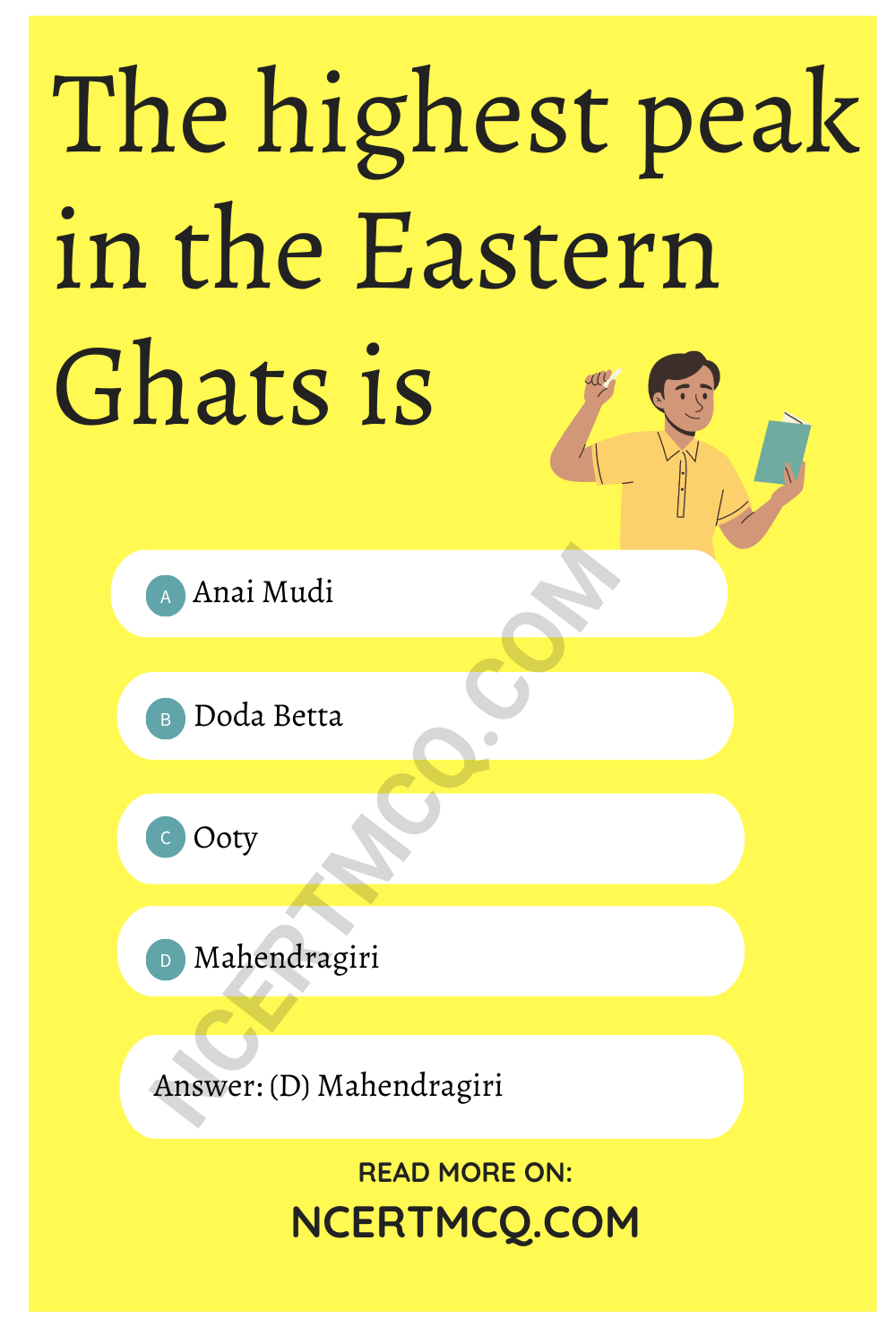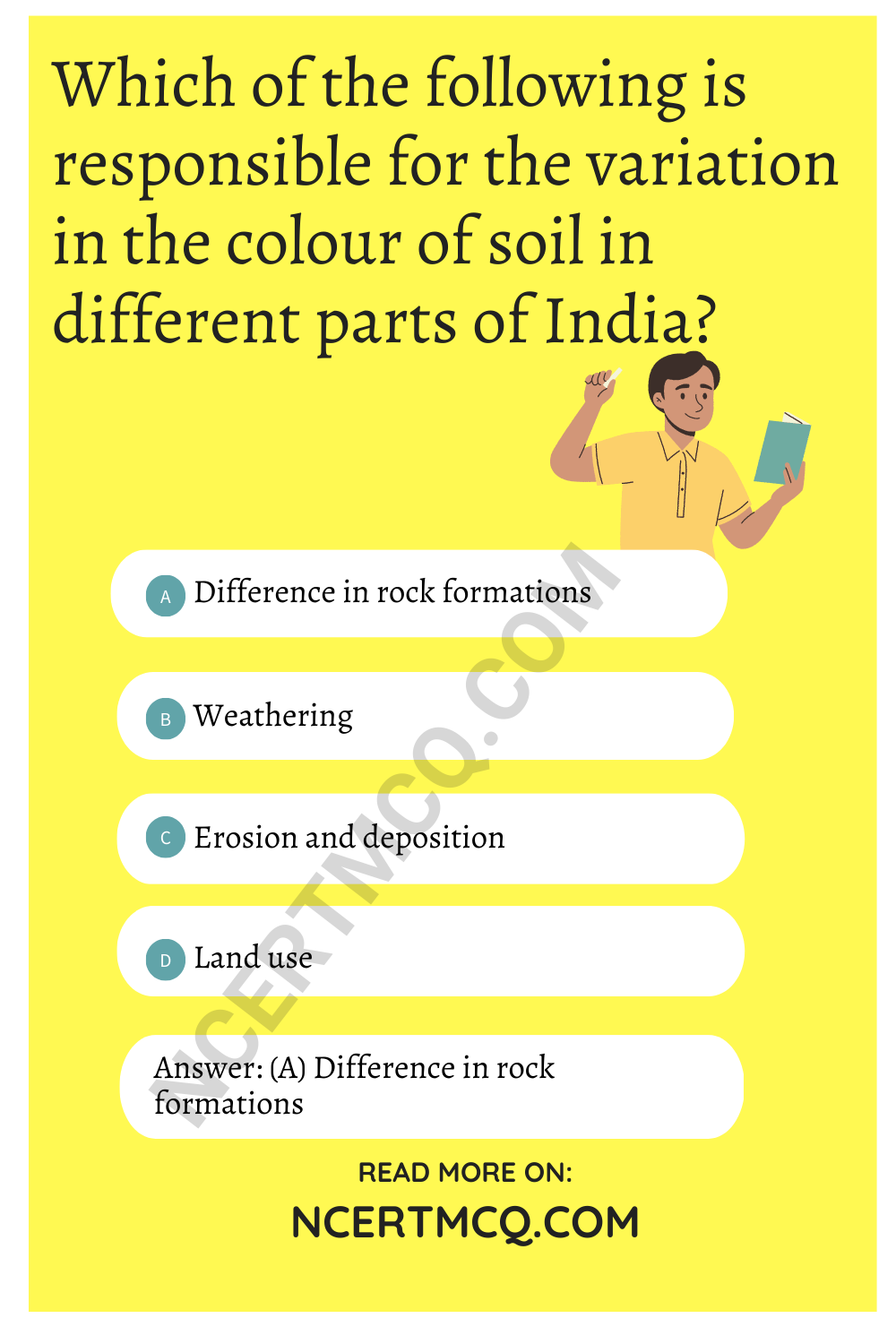Check the below NCERT MCQ Questions for Class 9 Geography Chapter 2 Physical Features of India with Answers Pdf free download. MCQ Questions for Class 9 Social Science with Answers were prepared based on the latest exam pattern. We have Provided Physical Features of India Class 9 Geography MCQs Questions with Answers to help students understand the concept very well. https://ncertmcq.com/mcq-questions-for-class-9-social-science-with-answers/
Class 9 Social Science Geography Chapter 2 MCQ With Answers
Geography Class 9 Chapter 2 MCQs On Physical Features of India
Choose the correct option:
Physical Features Of India Class 9 MCQ Question 1.
The northern most range of the Himalayas is known as
(a) Himadri
(b) lesser Himalaya
(c) Shivalik
(d) none of the above.
Answer
Answer: (a) Himadri
Physical Features Of India MCQ Question 2.
The Kangra and Kullu valley are located in
(a) Uttarakhand
(b) Jammu and Kashmir
(c) Himachal Pradesh
(d) Uttar Pradesh
Answer
Answer: (c) Himachal Pradesh
Class 9 Geography Chapter 2 MCQ Question 3.
Majuli is a riverine island located in the river
(a) Ganga
(b) Brahmaputra
(c) Yamuna
(d) Kaveri
Answer
Answer: (b) Brahmaputra
Class 9 Geography Chapter 2 MCQ With Answers Question 4.
Dudhwa National Park is located in the state of
(a) Assam
(b) Uttar Pradesh
(c) Madhya Pradesh
(d) Rajasthan
Answer
Answer: (b) Uttar Pradesh
Geography Class 9 Chapter 2 MCQ Question 5.
The soil containing calcareous deposits is locally known as
(a) Bhangar
(b) Khadar
(c) Bhabar
(d) Kankar
Answer
Answer: (d) Kankar
Class 9 Physical Features Of India MCQ Question 6.
The highest peak in the Eastern Ghats is
(a) Anai Mudi
(b) Doda Betta
(c) Ooty
(d) Mahendragiri
Answer
Answer: (d) Mahendragiri

Geography Chapter 2 Class 9 MCQ Question 7.
Jaisalmer is in
(a) Himachal Pradesh
(b) Rajasthan
(c) Gujarat
(d) Uttar Pradesh
Answer
Answer: (b) Rajasthan
Ch 2 Geo Class 9 MCQ Question 8.
Barchans are found in
(a) desert regions
(b) plains
(c) plateaus
(d) hilly regions
Answer
Answer: (a) desert regions
MCQ Questions For Class 9 Geography Chapter 2 Question 9.
The northern part of the western coast is called the
(a) Konkan
(b) Kannad plain
(c) Malabar coast
(d) Coromandel coast
Answer
Answer: (a) Konkan
Class 9 Geo Ch 2 MCQ Question 10.
Lake Chilika lies in the state of
(a) Jharkhand
(b) Telangana
(c) Odisha
(d) Tamil Nadu
Answer
Answer: (c) Odisha
MCQ Chapter 2 Geography Class 9 With Answers Question 11.
A landmass bounded by sea on three sides is referred to as
(a) Coast
(b) Island
(c) Peninsula
(d) None of the above
Answer
Answer: (c) Peninsula
Chapter 2 Geography Class 9 MCQ Question 12.
Mountain ranges in the eastern part of India forming its boundary with Myanmar are collectively called as
(a) Himachal
(b) Uttarakhand
(c) Purvachal
(d) none of the above
Answer
Answer: (c) Purvachal
Ch 2 Geography Class 9 MCQ Question 13.
The western coastal strip, south of Goa is referred to as;
(a) Coromandel
(b) Konkan
(c) Kannad
(d) Northern Circar
Answer
Answer: (c) Kannad
Class 9th Geography Chapter 2 MCQ Question 14.
The highest peak in the Eastern Ghats is
(a) Anai Mudi
(b) Kanchenjunga
(c) Mahendragiri
(d) Khasi
Answer
Answer: (c) Mahendragiri
Geo Ch 2 Class 9 MCQ Question 15.
A narrow gap in a mountain range providing access to the other side is :
(a) Mound
(b) Pass
(c) Strait
(d) Valley
Answer
Answer: (b) Pass
Question 16.
Which two hills are located in the south-east of Eastern Ghats ?
(a) Mizo Hills and Naga Hills
(b) Javadi Hills and Shevroy Hills
(c) Patkoi Hills and Manipuri Hills
(d) Mizo Hills and Patkoi Hills
Answer
Answer: (b) Javadi Hills and Shevroy Hills
Question 17.
The longitudinal valleys lying between lesser Himalayas and Shivaliks are known as .
(a) Kangra Valley
(b) Patkai Bum
(c) Passes
(d) Duns
Answer
Answer: (d) Duns
Question 18.
In which division of the Himalayas are the famous valleys of Kashmir, Kangra and Kullu located?
(a) The Himadri
(b) The Himachal
(c) The Shivaliks
(d) The Duns
Answer
Answer: (b) The Himachal
Question 19.
What are Lesser Himalayas known as?
(a) Himadri
(b) Himachal
(c) Shivaliks
(d) Purvanchal
Answer
Answer: (b) Himachal
Question 20.
Which of the following is the highest peak in India?
(a) Mt. Everest
(b) Kanchenjunga
(c) Nanga Parbat
(d) Nandadevi
Answer
Answer: (b) Kanchenjunga
Question 21.
The Himalayas consist of three parallel ranges in its longitudinal extent. Which of the following is the name of the northern-most range?
(a) The Himadri
(b) The Himachal
(c) The Shivaliks
(d) The Purvanchal
Answer
Answer: (a) The Himadri
Question 22.
Which of the following are young-fold mountains?
(a) The Aravalis
(b) The Nilgiris
(c) The Himalayas
(d) The Sahyadri
Answer
Answer: (c) The Himalayas
Question 23.
Geologically, which of the following physiographic divisions of India is supposed to be one of the most stable land blocks?
(a) The Himalayas
(b) The Northern Plains
(c) The Peninsular Plateau
(d) The Indian Desert
Answer
Answer: (c) The Peninsular Plateau
Question 24.
Which of the following physiographic divisions of India was formed out of accumulations in the Tethys geosyncline?
(a) The Himalayas
(b) The Northern Plains
(c) The Peninsular Plateau
(d) The Indian Desert
Answer
Answer: (a) The Himalayas
Question 25.
Which of the following countries or continents was not a part of the ancient landmass of Gondwanaland?
(a) India
(b) Australia
(c) Europe
(d) South America
Answer
Answer: (c) Europe
Question 26.
Which of the following divisions of India has the oldest landmass?
(a) The Himalayas
(b) The Northern Plains
(c) The Peninsular Plateau
(d) The Indian Desert
Answer
Answer: (c) The Peninsular Plateau
Question 27.
According to the ‘Theory of Plate Tectonics,’ what have been the effects of the movement of the plates?
(a) Change in position and size of continents.
(b) Formation of ocean basins.
(c) Evolution of the present landforms and relief of India.
(d) All of the above.
Answer
Answer: (d) All of the above.
Question 28.
According to the ‘Theory of Plate Tectonics,’ when some plates move away from each other, which of the following is formed?
(a) Convergent boundary
(b) Divergent boundary
(c) Transform boundary
(d) None of the above
Answer
Answer: (b) Divergent boundary
Question 29.
According to the ‘Theory of Plate Tectonics,’ the movement of the plates result in some geological activity. Which one of the following is not such a geological activity?
(a) Volcanic activity
(b) Folding
(c) Faulting
(d) Glaciation
Answer
Answer: (d) Glaciation
Question 30.
Which of the following is a plausible theory presented by Earth scientists to explain the formation of continents and oceans and the various landforms?
(a) Theory of Motion
(b) Theory of Plate Tectonics
(c) Theory of Evolution
(d) Theory of Relativity
Answer
Answer: (b) Theory of Plate Tectonics
Question 31.
Which of the following is responsible for the variation in the colour of soil in different parts of India?
(a) Difference in rock formations
(b) Weathering
(c) Erosion and deposition
(d) Land use
Answer
Answer: (a) Difference in rock formations

Find out some regional names of the Himalayas.
Answer
Answer:
Some regional names of the Himalayas are:
- Sagarmatha Himal
- Annapurna Himal
- Ganesh Himal
- Langtang Himal
- Khumbu Himal
- Dhaulagiri Himal
- Purvachal
- Gauri Shankar Himal
Name the famous hill stations of Udagamandalam.
Answer
Answer:
- Adam’s Fountain
- Annamalai Ashram Temple
- Bison Valley
- Cairn Hill
- Coonoor
- Doddabetta Peak
The middle Himalaya is well known for its hill stations. Name some of them.
Answer
Answer:
- Dalhousie
- Manali
- Shimla
- Nainital
- Mussoorie
- Darjeeling
We hope the given NCERT MCQ Questions for Class 9 Geography Chapter 2 Physical Features of India with Answers Pdf free download will help you. If you have any queries regarding Physical Features of India CBSE Class 9 Geography MCQs Multiple Choice Questions with Answers, drop a comment below and we will get back to you soon.
Class 9 Social Science Geography MCQ:
